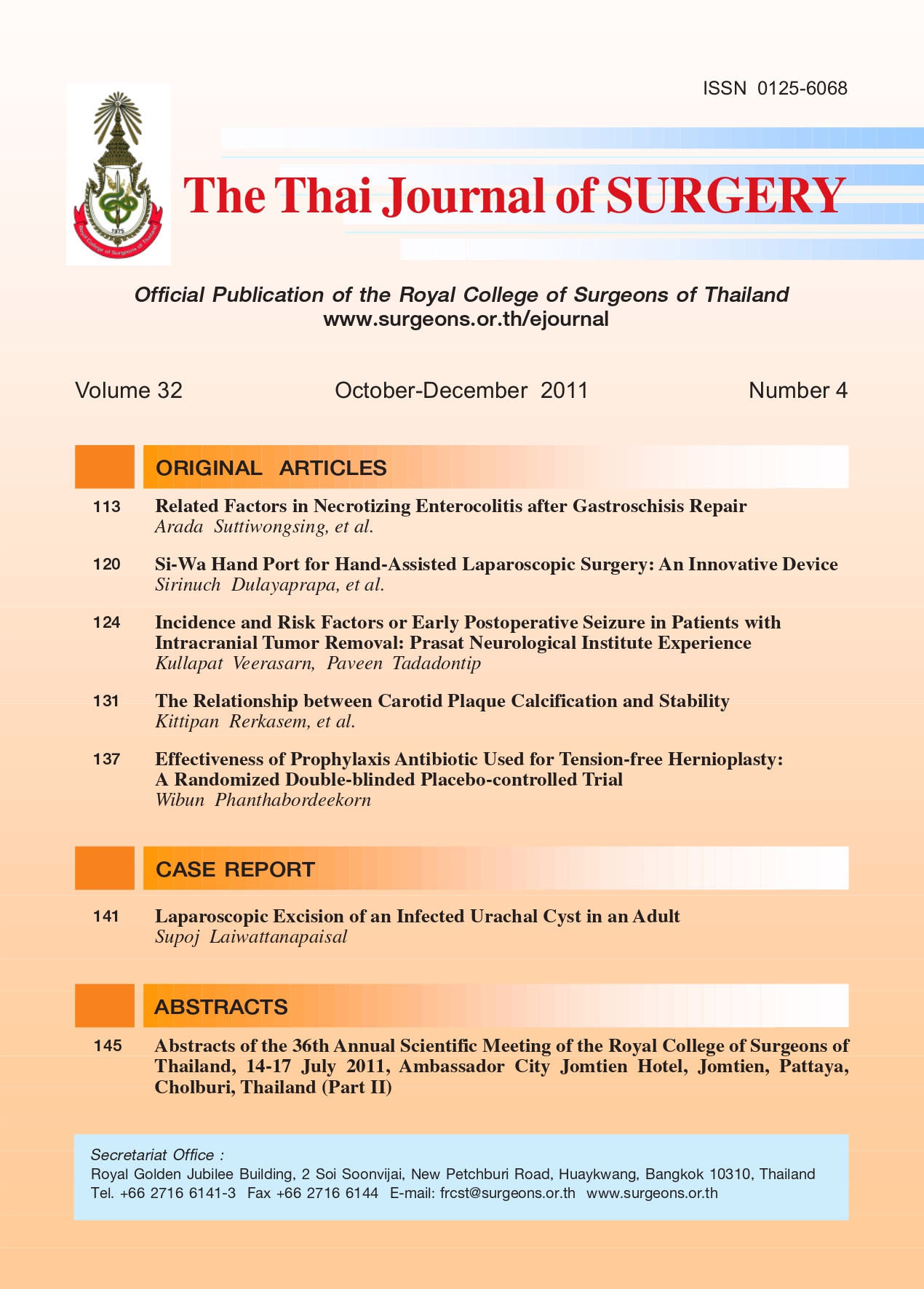The Effectiveness of Vacuum Assisted Closure (VAC) for Securing of Skin Graft: A Prospective Study in a Rural Hospital
Keywords:
skin graft, vacuum-assisted closure, wound dressingAbstract
Objective: To determine the effectiveness of vacuum-assisted closure (VAC) by modified simple-to-useVAC system over the skin graft.
Materials and Methods: A prospective study was carried out to include twenty-four consecutive patients
who underwent partial thickness skin grafting for lower and upper limb, trunk, chest wall and abdominal wall
defects at the surgical ward in the Phukieo Rural Hospital, Thailand, from July 2007 to January 2012. The
dressing comprised cut foam sheet, a modified portable closed system-suction drain connected to naso-gastric
tube and covered by an adhesive film. Graft-take rate and cost per case were evaluated.
Result: Graft-take was 100% in 15 of 24 patients (63%) and 9 patients (17%) had partial graft loss. No
serious complications were encountered. Cost analysis demonstrated a minimum treatment cost of 2,355 baht
over 5 days compared with commercial VAC dressing (20,900baht/5 days),and it was more convenient than other
methods of skin graft dressing.
Conclusions: The use of negative pressure dressing by modified simple-to-use VAC system is an effective
and safe alternative method to secure the skin graft on the wound bed for the treatment soft tissue defect.
References
vacuum-assisted closure (VAC) as a negative pressure
dressing in lower limb split skin grafting: a clinical trial. J Plast
Reconstr Aesth Surg 2007;20:1-4.
2. Smahel J. The healing of skin grafts. Clin Plast Surg 1977;4:409-
24.
3. Chang KP, Tsai CC, Lin TM, Lai CS, Lin SD. An alternative
dressing for skin graft immobilization: negative pressure
dressing. Burns 2001;27:839-42.
4. Vidrine DM, Kaler S, Rosenthal EL. A Comparison of negative
pressure dressing versus Bolster and splinting of the radial
forearm donor site. Otolaryngol Head Neck Surg 2005;133:
403-6.
5. Llanos S, Danilla S, Barraza C, Armijo E, Piñeros JL, Quintas M,
et al. Effectiveness of negative pressure closure in the
integration of split thickness skin grafts: a randomized, doublemasked,
controlled trial. Ann Surg 2006;244:700e5.
6. Moisidis E, Heath T, Boorer C, Ho K, Deva AK. A prospective,
blinded, randomized, controlled clinical trial of topical
negative pressure use in skin grafting. Plast Reconstr Surg
2004;15:917e22.
7. Vuerstaek JD, Vainas T, Wuite J, Nelemans P, Neumann MH,
Veraart JC. State-of-the-art treatment of chronic leg ulcers:
a randomized controlled trial comparing vacuum-assisted
closure (V.A.C.) with modern wound dressings. J Vasc Surg
2006;44:1029 e37.
8. Scherer LA, Shiver S, Chang M, Meredith JW, Owings JT. The
vacuum assisted closure device: a method of securing skin
grafts and improving graft survival. Arch Surg 2002;137:930
e3.
9. Korber A, Franckson T, Grabbe S. Vacuum assisted closure
device improves the take of mesh grafts in chronic leg ulcer
patients. Dermatology 2008;216:250e6.
10. Mouës CM, Heule F, Hovius SER. A review of topical negative
pressure therapy in wound healing: sufficient evidence?
Am J Surg 2011;201:544-56.
11. Plikaitis CM, Molnar JA. Subatmospheric pressure wound
therapy and the vacuum-assisted closure device: basic
science and current clinical success. Expert Rev Med Devices
2006;3:175-84.
12. Kamolz LP, Andel H, Haslik W, Winter W, Meissl G, Frey M.Use
of subatmospheric pressure therapy to prevent burn wound
progression in human: first experiences. Burns 2004;30:253-8.
13. Wackenfors A, Sjogren J, Gustafsson R, Algotsson L,
Ingemansson R, Malmsjö M. Effects of vacuum-assisted
closure therapy on inguinal wound edge microvascular
blood flow. Wound Repair Regen 2004;12:600-6.
14. Suess JS, Kim PJ, Steinberg JS. Negative pressure wound
therapy: Evidence-based treatment for complex diabetic
foot wounds. Curr Diabetes Rep 2006;6:446-450
15. Wackenfors A, Gustafsson R, Sjogren J, Algotsson L, Richard
Ingemansson R, Malmsjö M. Blood flow responses in the
peristernal thoracic wall during vacuum-assisted closure
therapy. Ann Thorac Surg 2005;79:1724-3.
16. Morykwas MJ, Argenta LC, Shelton-Brown El, McGuirt W.
Vacuum-assisted closure: a new method for wound control
and treatment: animal studies and basic foundation. Ann
Plast Surg 1997;93:32-3.
17. Sdawat R, Srimuninnimit V, Kanogsunthornrat N. Clininical
use of Vacuum Assisted Closure (V.A.C.) by modified
material. Sawanpracharak Med J 2006;3:384-96.
18. Sarovath A, Chartdokmaiprai C, Kruavit A. Vacuum-assisted
closure: A reliable method to secure skin graft. Thai J Surg
2005;26:32-8.
19. PhilbeckJr TE, Whittington KT, Millsap MH, Briones RB, Wight
DG, Schroeder WJ.The clinical and cost effectiveness of
externally applied negative pressure wound therapy in the
treatment of wound s in home health care Medicare patients.
Ostomy Wound Manage 1999;4:41-50.
20. Petkar KS, Dhanraj P, Kingsly PM, Sreekar H, Lakshmanara A,
Lamba S, et al. A prospective randomized controlled trial
comparing negative pressure dressing and conventional
dressing methods on split-thickness skin grafts in burned
patients. Burn 2011;37:925-9.
21. Rosenthal EL, Blackwell KE, McGrew B, Carroll WR, Peters GE.
Use of negative pressure dressings in head and neck
reconstruction. Head Neck 2005;27:970-5.
22. Brandi C, Grimaldi L, Nisi G, Silvestri A, Brafa A, Calabrò M, et
al. Treatment with vacuum-assisted closure and cryopreserved
homologous de-epidermalised dermis of complex
traumas tothe lower limbs with loss of substance, and bones
and tendons exposure. J Plast Reconstr Aesthet Surg 2008;
61:1507-11.
23. Körber A, Franckson T, Grabbe S, Dissemond J. Vacuum
assisted closure device improves the take of mesh grafts in
chronic leg ulcer patients. Dermatology 2008;216:250e6.
24. Etöz A, Özgenel Y, Özcan M. The use of negative pressure
wound therapy on diabetic foot ulcers: a preliminary
controlled trial. Wounds 2004;16: 264e9.
25. Kruga E, Bergb L,Leec C, Hudsond D, Birke-Sorensene H,
Depoorterf M. Evidence-based recommendations for the
use of negative pressure wound therapy in traumatic wounds
and reconstructive surgery: steps towards an international
consensus. Injury Int J Care Injured 2011;42:S1, S1-S12
Downloads
Published
How to Cite
Issue
Section
License
Articles must be contributed solely to The Thai Journal of Surgery and when published become the property of the Royal College of Surgeons of Thailand. The Royal College of Surgeons of Thailand reserves copyright on all published materials and such materials may not be reproduced in any form without the written permission.


